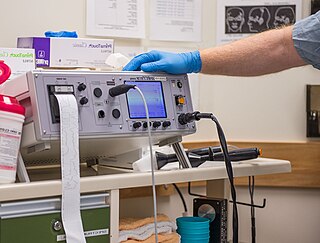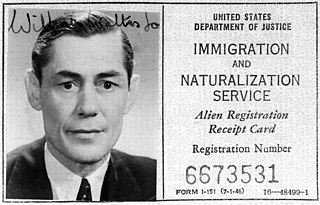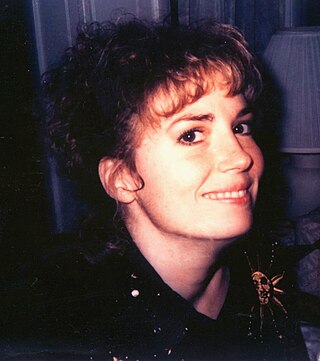Related Research Articles

Electroconvulsive therapy (ECT) or electroshock therapy (EST) is a psychiatric treatment where a generalized seizure is electrically induced to manage refractory mental disorders. Typically, 70 to 120 volts are applied externally to the patient's head, resulting in approximately 800 milliamperes of direct current passing between the electrodes, for a duration of 100 milliseconds to 6 seconds, either from temple to temple or from front to back of one side of the head. However, only about 1% of the electrical current crosses the bony skull into the brain because skull impedance is about 100 times higher than skin impedance.
Stephen Paul Cannane is a news journalist and current affairs reporter for the Australian Broadcasting Corporation. He is the chief of the ABC's Europe bureau, based in London. Cannane had previously been the ABC's Europe correspondent, a reporter for the ABC's Investigations unit, a host of The Drum and a reporter at Lateline.
Peter Roger Breggin is an American psychiatrist and critic of shock treatment and psychiatric medication and COVID-19 response. In his books, he advocates replacing psychiatry's use of drugs and electroconvulsive therapy with psychotherapy, education, empathy, love, and broader human services.

William Walters Sargant was a British psychiatrist who is remembered for the evangelical zeal with which he promoted treatments such as psychosurgery, deep sleep treatment, electroconvulsive therapy and insulin shock therapy.

Since the founding of the Church of Scientology in 1954 by L. Ron Hubbard, the relationship between Scientology and psychiatry has been dominated by strong opposition by the organization against the medical specialty of psychiatry and of psychology with themes relating to this opposition occurring repeatedly throughout Scientology literature and doctrine. According to the Church of Scientology, psychiatry has a long history of improper and abusive care. The group's views have been disputed, criticized, and condemned by experts in the medical and scientific community and have been a source of public controversy.

Insulin shock therapy or insulin coma therapy was a form of psychiatric treatment in which patients were repeatedly injected with large doses of insulin in order to produce daily comas over several weeks. It was introduced in 1927 by Austrian-American psychiatrist Manfred Sakel and used extensively in the 1940s and 1950s, mainly for schizophrenia, before falling out of favour and being replaced by neuroleptic drugs in the 1960s.

Harry Richard Bailey was an Australian psychiatrist and hospital administrator. He bore the primary responsibility for treatment of mental health patients and drug dependent clients via deep sleep therapy and other methods at a mental hospital in the Sydney North Shore suburb of Pennant Hills where he was its principal. The treatment has been linked with the deaths of a total of 85 patients, including 19 who committed suicide. Bailey committed suicide while he was being investigated. One of Bailey's clients was Australian rock and pop singer and songwriter Stevie Wright, who was being treated for methadone addiction, a report that was later part of a 2013 documentary on Australian Story.
The Royal Commission into Mental Health Services, more commonly known as the Chelmsford Royal Commission (1988–1990), was a royal commission in the Australian state of New South Wales, chaired by Justice John Patrick Slattery. Established by the Government of New South Wales ostensibly to investigate mental health services in the state, the royal commission came about only after prominent Sydney radio and television shows pressured the newly elected Health Minister, Peter Collins, to make good his promises for a Royal Commission.

The Callan Park Hospital for the Insane (1878–1914) is a heritage-listed former insane asylum, which was subsequently, for a time, used as a college campus, located in the grounds of Callan Park, an area on the shores of Iron Cove in Lilyfield, a suburb of Sydney, New South Wales, Australia. In 1915, the facility was renamed as the Callan Park Mental Hospital and, again in 1976, to Callan Park Hospital. Since 1994, the facility has been formally known as Rozelle Hospital. In April 2008, all Rozelle Hospital services and patients were transferred to Concord Hospital. The Callan Park Act, 2002 (NSW) restricts future uses of the site to health, tertiary education and community uses.
Eric Cunningham Dax, AO, FRACP, FRANZCP, HonFRCPsych was a British-born Australian psychiatrist.
Child and adolescent psychiatry is a branch of psychiatry that focuses on the diagnosis, treatment, and prevention of mental disorders in children, adolescents, and their families. It investigates the biopsychosocial factors that influence the development and course of psychiatric disorders and treatment responses to various interventions. Child and adolescent psychiatrists primarily use psychotherapy and/or medication to treat mental disorders in the pediatric population.
Electroconvulsive therapy is a controversial psychiatric treatment in which seizures are induced with electricity. ECT was first used in the United Kingdom in 1939 and, although its use has been declining for several decades, it was still given to about 11,000 people a year in the early 2000s.
Maximilian Fink is an American neurologist and psychiatrist best known for his work on ECT. His early work also included studies on the effect of psychoactive drugs on brain electrical activity; more recently he has written about the syndromes of catatonia and melancholia.

Flurothyl (Indoklon) is a volatile liquid drug from the halogenated ether family, related to inhaled anaesthetic agents such as diethyl ether, but having the opposite effects, acting as a stimulant and convulsant. A clear and stable liquid, it has a mild ethereal odor whose vapors are non-flammable. It is excreted from the body by the lungs in an unchanged state.

The Citizens Commission on Human Rights International (CCHR) is a nonprofit organization established in 1969 by the Church of Scientology and psychiatrist Thomas Szasz, headquartered in Los Angeles, California. Its stated mission is to "eradicate abuses committed under the guise of mental health and enact patient and consumer protections." Many critics regard it as a Scientology front group whose purpose is to push the organization's anti-psychiatric agenda.
Ted Chabasinski is an American psychiatric survivor, human rights activist and attorney who lives in Berkeley, California. At the age of six, he was taken from his foster family's home and committed to a New York psychiatric facility. Diagnosed with childhood schizophrenia, he underwent intensive electroshock therapy and remained an inmate in a state psychiatric hospital until the age of seventeen. He subsequently trained as a lawyer and became active in the psychiatric survivors movement. In 1982, he was a leader in an initially successful campaign seeking to ban the use of electroshock in Berkeley, California.

William Jefferson Bleckwenn was an American neurologist, psychiatrist, and military physician, who was instrumental in developing the treatment known as "narcoanalysis" or "narcosynthesis", also known by the lay term "truth serum".

The lunatic asylum, insane asylum or mental asylum was an early precursor of the modern psychiatric hospital.
The following outline is provided as an overview of and topical guide to psychiatry:

David John Impastato was an American neuropsychiatrist who pioneered the use of electroconvulsive therapy (ECT) in the United States. A treatment for mental illness initially called "electroshock," ECT was developed in 1937 by Dr. Ugo Cerletti and Lucio Bini, working in Rome. Impastato has been credited with the earliest documented use of the revolutionary method in North America, administered in early 1940 to a schizophrenic female patient in New York City. Soon after, he and colleague Dr. Renato Almansi completed the first case study of ECT to appear in a U.S. publication. Impastato spent the next four decades refining the technique, gaining recognition as one of its most authoritative spokesmen. He taught, lectured widely and published over fifty articles on his work. He called on ECT practitioners to observe the strictest protocols of patient safety, countered resistance to ECT from both the medical and cultural establishments, and met later challenges to electroconvulsive therapy from developments in psychopharmacology. Impastato would live to see ECT recommended by the American Psychiatric Association for a distinct core of intractable mental disorders. The U.S. Food and Drug Administration took longer to respond to the treatment's potential. But in 2016 the FDA drafted guidelines for ECT similar to those of the APA, as well as proposing regulations for treatment with Class II and Class III devices. Though still not free of controversy, electroconvulsive therapy is the treatment of choice for an estimated 100,000 patients a year in the United States.
References
- The New South Wales Royal Commission into Chelmsford Private Hospital: Available in reference form at the N.S.W. State Library.
- Jones, D. Gareth. (March 1990) "Contemporary Medical Scandals: A Challenge to Ethical Codes and Ethical Principles." Perspectives on Science and Christian Faith. No. 42, pp. 2–14
- Anderson, Ian. (January 1991) "Nightmare on Chelmsford, Sydney." New Scientist , No. 1750, 5 January 1991 (subscription required for full article)